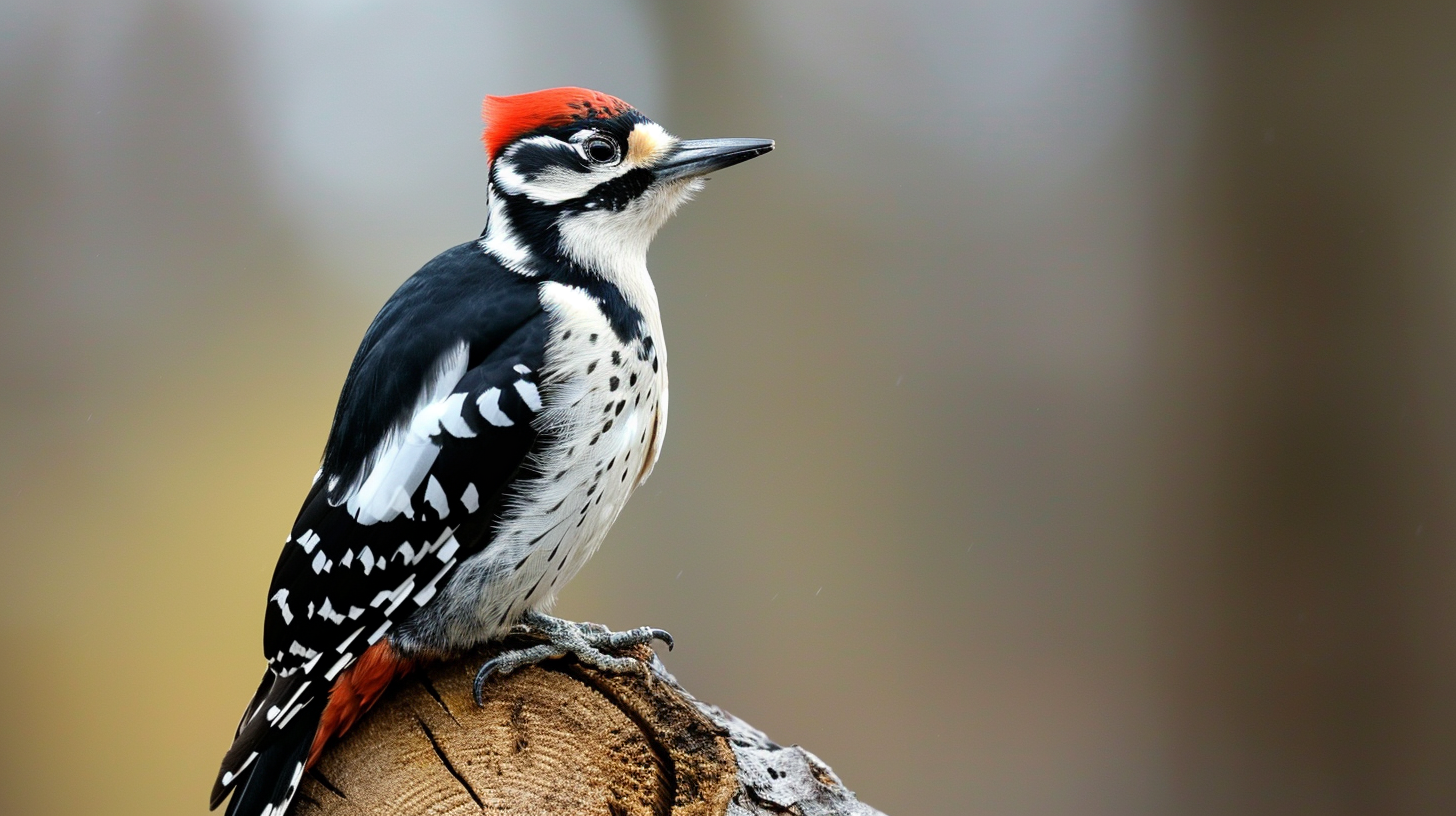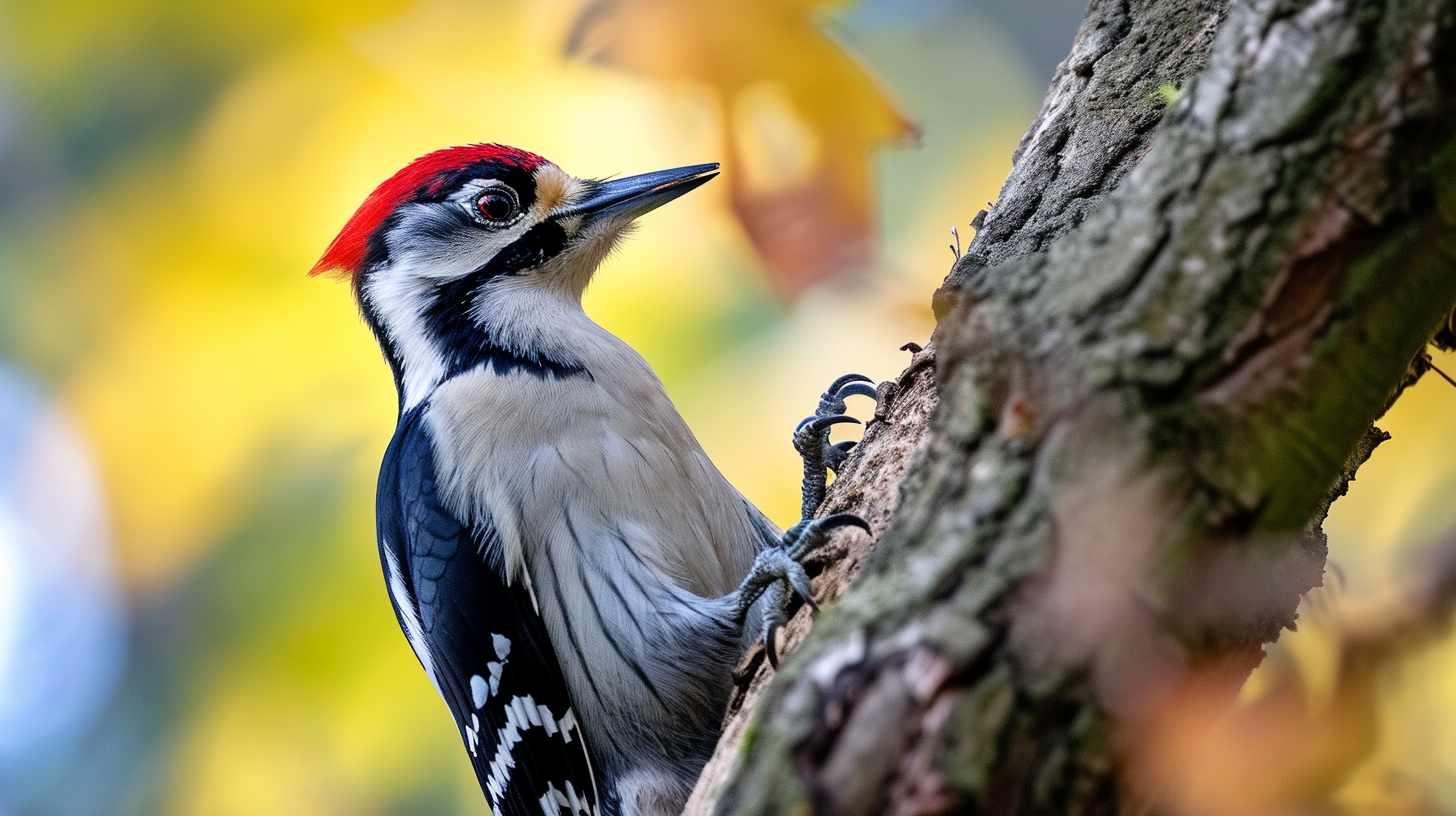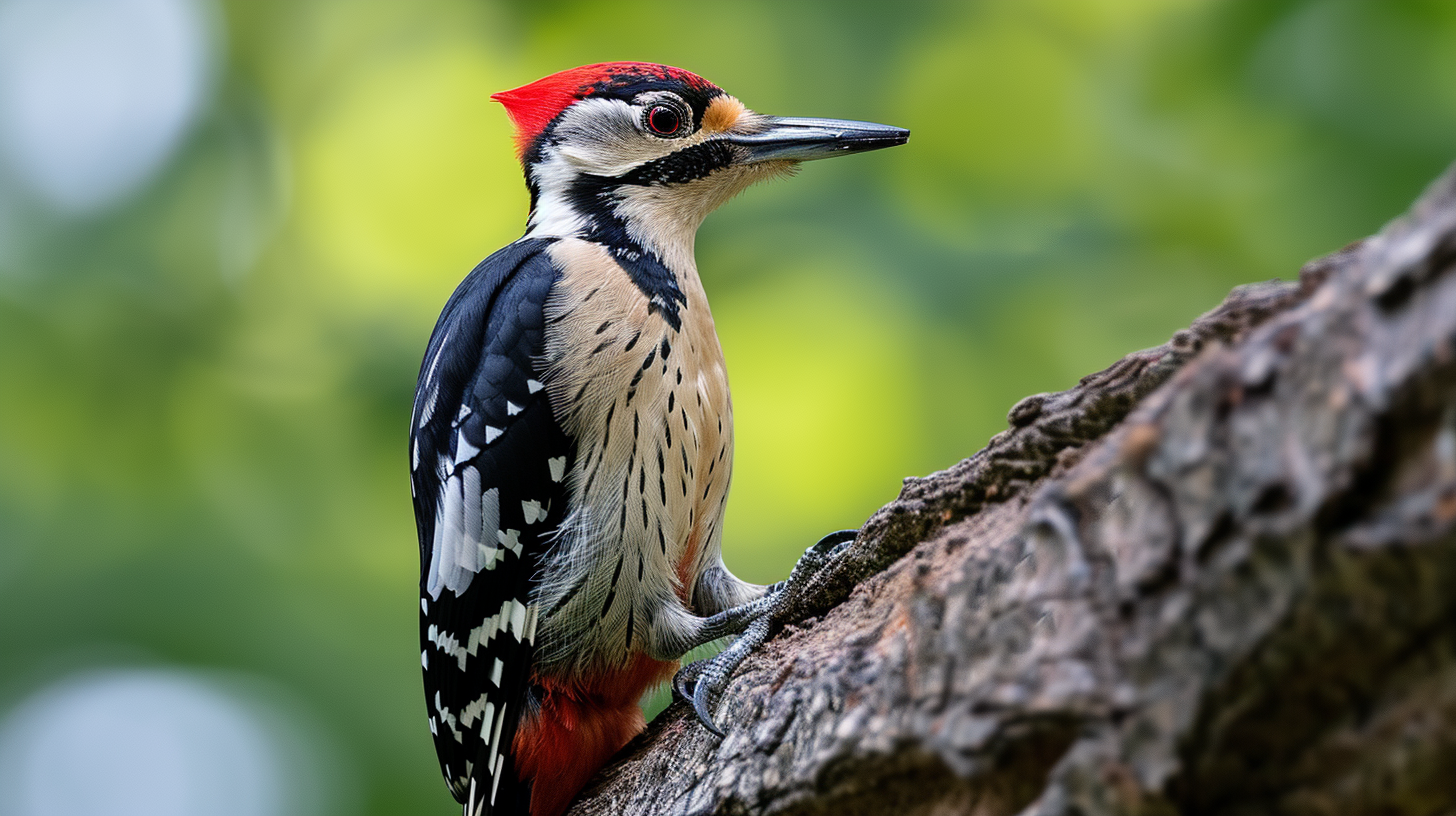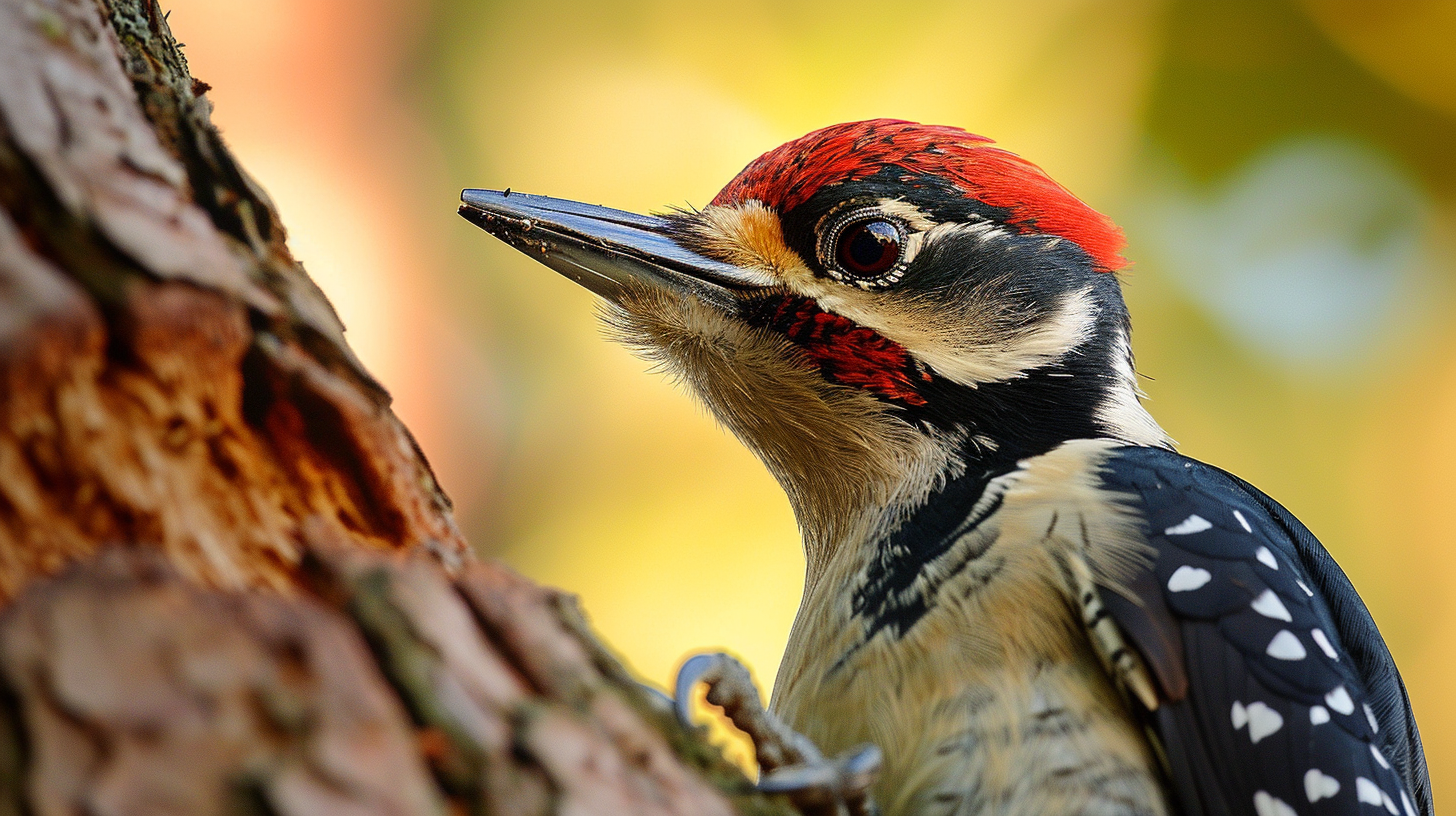Are you curious about the fascinating world of woodpeckers? Look no further! From their unique adaptations to their important role in the ecosystem, these birds have captured the attention of nature enthusiasts for centuries.
But with over 200 species worldwide, navigating through the abundance of information can be overwhelming.
That’s where we come in. In this ultimate guide to woodpeckers, we’ll dive deep into everything you need to know about these incredible creatures.

What Is A Woodpecker?
Woodpeckers are a group of bird species known for their unique behavior of pecking at wood. I recognize them as members of the family Picidae, which includes over 200 species distributed across the world.
Their drumming on trees is not only a search for food but also a means of communication. Woodpeckers vary in size and can be found in various habitats, ranging from forests to urban areas.
One of the most captivating species within this family is the Ivory-billed Woodpecker, often noted for its striking appearance.
Despite being elusive and feared extinct, it remains an iconic example of the beauty and mystery that woodpeckers represent. Throughout my observations, I’ve noted the distinct physical attributes of woodpeckers, such as their strong bills for drilling into wood and long tongues for extracting insects.
The diversity within the woodpecker family is remarkable. These beautiful birds display an array of colors and patterns, with some species boasting vibrant red markings on their heads.
The diversity is also evident in their various calls and behaviors, which further distinguishes the numerous types of woodpeckers.
Each species plays a crucial role in their ecosystem, contributing to the balance of their respective environments.
Acknowledging the range of species within the woodpecker family, I continue to be fascinated by their adaptability and resilience. Their presence is a testament to the rich tapestry of bird life that populates our planet.
How Many Types Of Woodpecker Are There?
Across the United States, I can identify 23 native woodpecker species, each with unique characteristics and habits. Here, I’ll provide an overview of the key species that birdwatching enthusiasts and nature lovers frequently encounter.
Here’s an organized list showcasing some of these amazing species:
- Downy Woodpecker: The smallest woodpecker in North America, often found in wooded suburbs and parks.
- Pileated Woodpecker: One of the largest, most striking forest birds with a prominent red crest.
- Hairy Woodpecker: Looks similar to the Downy, but larger and with a longer bill.
- Northern Flicker: Known for its distinct hammering on metal surfaces and ground foraging habits.
- Yellow-bellied Sapsucker: Recognizable by the neat rows of holes it drills in trees.
- Red-headed Woodpecker: With a completely red head and neck, this species is easy to spot.
- Red-bellied Woodpecker: Despite its name, it’s more easily identified by the red cap and nape.
- Acorn Woodpecker: Renown for hoarding acorns in large communal trees, called granaries.
- American Three-toed Woodpecker: Exhibits a unique three-toed foot structure, unlike most woodpeckers.
- Imperial Woodpecker: Once the largest woodpecker species but is now sadly presumed extinct.
This list doesn’t include other important types like flickers – ground foragers with stunning plumage, wrynecks which are absent from North America, piculets, and the purely fictional Woody Woodpecker known from classic cartoons.
Each species plays a vital role in their ecosystems, not only as insect control agents but also as keystone species whose nesting habits benefit other wildlife.
What Does A Woodpecker Sound Like?
When I observe woodpeckers, I notice their sounds are just as distinctive as their pecking behavior. Their vocalizations typically include a variety of calls such as churrs, purrs, rattles, and chatters.
These sounds can serve numerous purposes from signaling alarm to communicating with a mate.
Woodpeckers are not just limited to vocal sounds; drumming is also a crucial part of their sound repertoire.
They drum by rapidly pecking with their beaks on wood—this can denote territory or serve as a mating call. It’s interesting to note that the rhythm and tempo of their drumming can be unique to different species.
Here’s a breakdown of woodpecker sounds:
- Calls: Short, often repeating notes like “peek” or “pik.”
- Drumming: A rapid succession of knocks against trees or other resonant objects.
It’s noteworthy that these sounds vary widely between species, but all serve a similar set of functions, such as defining territory or attracting a mate.
To my ear, the pattern and intensity of woodpecker drumming can sometimes be more informative than their calls, indicative of the woodpecker’s size and urgency.
Each woodpecker species has its distinct sound pattern, but across the board, their acoustic signals are an integral part of their behavioral toolkit, allowing them to communicate effectively within their dense forest habitats.

What Does A Woodpecker Look Like? What’s Their Wingspan?
When I study woodpeckers, my focus is on their physical characteristics, which reveal a great deal about their behavior and habitat adaptations.
Woodpeckers are generally known for their sharp, straight beaks or bills, which are perfect for drilling into wood.
They exhibit a shape that is well-suited for their tree-climbing life, with short, strong legs and stiffened tails that aid in support and balance while they peck.
Plumage can be quite varied among species but often includes bold patterns for camouflage with some woodpeckers displaying spectacular red markings, especially males.
When describing their size, woodpeckers generally range from small to medium-sized birds.
A key aspect of their morphology is their special, long, sticky tongues that can spear and extract insects and larvae from deep within trees.
As for the wingspan, this is another point of variation among species. To illustrate, here are typical wingspan ranges in relation to size for a clearer understanding:
| Size Category | Average Wingspan |
|---|---|
| Small | 12-16 inches (30-41 cm) |
| Medium | 16-22 inches (41-56 cm) |
Remember that these measurements can vary broadly depending on the specific type of woodpecker.
Despite their sturdy build for pecking, woodpeckers have relatively short legs, which aren’t meant for walking on the ground but are rather adapted to cling to vertical surfaces.
Where Are Woodpeckers Most Commonly Found?
Woodpeckers, an intriguing family of birds, are predominantly found in North America, especially within the United States.
I have located these birds in various habitats, ranging from dense forests to suburban yards. They are not limited to any single environment, though they have a marked preference for wooded areas, where they can forage, nest, and thrive.
In the U.S., some species like the Hairy Woodpecker are widespread, found from coast to coast.
As for specific environments, some reside in urban areas and parks, adapting well to the presence of humans. I’ve observed that these areas provide ample nesting sites and feeding opportunities.
Woodpeckers are adaptable, and several species even live in arid regions like deserts, utilizing available resources.
However, outside of North America, woodpeckers span across Eurasia and parts of Africa, where their chosen habitats can vary significantly.
They are less common in arid and desert regions, showing a marked preference for regions rich in trees.
Their presence in a yard indicates a healthy ecosystem — a balance that these birds help maintain. They often seek trees plagued by insects, providing natural pest control.
It is fascinating how some woodpecker species have become comfortable in urban areas, often spotted in parks and reserve lands within city bounds.
Yet, they predominantly flourish in areas that offer tree density, such as forests and deciduous woodlands, places where their characteristic pecking is often heard, as they seek insects or create nesting cavities.

What Do Woodpeckers Symbolize?
In many cultures, woodpeckers are seen as symbols of strength, determination, and resilience. Their ability to peck into trees with precision and speed represents their perseverance and hard work.
They are also known for their sharp senses, reminding us to stay alert and pay attention to our surroundings.
In Native American mythology, woodpeckers are often associated with the spirit world and believed to bring messages from the afterlife.
Then, in some cultures, they are thought to be a symbol of good luck and protection. Overall, woodpeckers symbolize tenacity in the face of challenges and serve as a reminder to never give up on our goals and dreams.
What Is The Diet Of Woodpeckers?
Notable Insect Preferences:
- Ants
- Beetles
- Grubs
In addition to insects, woodpeckers don’t shy away from enjoying other foods in their diet, depending on availability.
For instance, they consume sap from trees, which they access through holes that they drill in the bark. The sap’s sweetness and nutrients offer a change from their usual insect-rich diet.
Other Dietary Components:
- Nuts
- Berries: When available, they provide a supplemental source of food.
- Acorns: Particularly favored by some of my relatives, like the Acorn Woodpecker.
- Seeds: Black oil sunflower seeds are among their preferences, particularly because they are rich in fat—vital for their energy needs.
- Fruits: In the right season, these are a welcome addition.
- Suet: Often drawn to suet feeders in backyards as they provide high-energy fat that is crucial, especially during colder months.
Where Do Woodpeckers Nest?
Woodpeckers are remarkable cavity nesters, and their nesting habits are a testament to their industrious nature.
I find that when they’re ready to nest, they generally prefer dead or decaying trees, particularly oak trees, which provide an optimal balance of soft enough wood for digging but enough structural integrity to support a nest.
The tree trunk serves as the primary site for their home.
The process of creating a nest involves the woodpecker using its sharp beak to carve out a cavity. Here’s a brief rundown of their nesting preferences:
- Tree Preference: Typically, dead trees or branches are used for their softer wood, known as snags. However, if natural options are scarce, some species are content with using nest boxes provided by humans.
- Cavity Creation: The entrance to the cavity is usually round and just large enough to allow the bird access. Inside, the cavity is larger to accommodate the bird and its future offspring.
Woodpecker nests are not lined with material like many other birds’ nests; they are often bare, aside from the wood chips created from excavating the cavity.
As a result, when the female lays eggs, they rest on the fine bedding of wood debris.
I observe that nesting sites are usually created new each year, leaving previous nests for other species to use.
This method showcases another layer of the woodpecker’s contribution to their ecosystem, providing habitats for other animals once they have moved on.
When Do Woodpeckers Lay Eggs?
Woodpeckers typically lay their eggs in the spring to mid-summer months, which can range from April through July.
The commencement of laying is often closely tied to environmental factors such as climate and geographic location, with some variations among different species.
As a woodpecker, I would choose my nesting site meticulously, often a tree cavity just wide enough to fit my body.
This intimate environment provides the ideal conditions for my eggs and future hatchlings. After meticulously preparing the nest, I would lay a clutch, often comprising 3 to 10 eggs, which varies by species.
Here’s a succinct breakdown of the laying process:
- Site Selection: Find a suitable nest site, a tree or cactus cavity.
- Egg Laying: Lay eggs over a series of days, frequently during the morning.
- Clutch Size: Typically lay between 3 to 10 eggs per clutch.
- Incubation: Both parents share incubation duties, lasts approximately 12 days.
How Can I Tell If A Woodpecker Is Male Or Female?
Identifying the gender of a woodpecker involves observing distinct physical characteristics that vary between males and females. Below, I’ve outlined key features to look for:
Downy Woodpecker:
- Male: Exhibit a red patch on the back of the head.
- Female: Lack the red patch.
Great Spotted Woodpecker:
- Male: Slightly larger with a red patch on the back of the head.
- Female: Absence of the red patch.
Pileated Woodpecker: Both sexes have white stripes on the throat and a black bill but exhibit subtle differences:
- Male: Bright red triangular-shaped crest.
- Female: Crest is less pronounced.
In general, male woodpeckers often display more vibrant and additional colors compared to their female counterparts.
Look for these markers when you observe woodpeckers in the wild to determine their gender.
Remember, each species may have varying identifiers, but the presence or absence of a red patch is a common and useful indicator.

How Long Do Woodpeckers Live?
The lifespan of a woodpecker can vary significantly from species to species. On average, these birds live between 5 to 11 years.
However, there have been instances where individual woodpeckers, like the Pileated Woodpecker, have lived for nearly 13 years.
- Average Lifespan: 5-11 years
- Recorded Lifespan: Pileated Woodpecker, up to 12 years and 11 months
Their lifespan in the wild is influenced by various factors such as predation, habitat quality, food availability, and interactions with diseases or humans.
I’ve found that woodpeckers that have adapted to suburban or urban environments might face different survival challenges compared to their forest-dwelling counterparts.
In my continued observation of woodpeckers, I’ve noticed that mature woodpeckers are skilled at avoiding predators.
This ability, combined with their innate skill of finding food, contributes to their potential to reach the upper end of their lifespan.
It is crucial to note that the first year of life is often the most perilous for these birds, but if they navigate through this critical period, their chances of a longer life significantly increase.
5 Interesting Facts About Woodpeckers
1. Unique Pecking Mechanism: My research shows that woodpeckers have a remarkable adaptation that allows them to peck at wood without damaging their brains. Their skulls have shock-absorbent structures that distribute the impact energy, allowing them to peck up to 20 times per second without injury.
2. Specialized Tongue: Woodpeckers possess an extraordinary tongue. For instance, the Pileated Woodpecker’s tongue can extend several inches to extract insects from deep crevices. Their tongues are sticky and sometimes barbed, aiding in the capture of prey.
3. Zygodactyl Feet: I’ve learned that these birds have two toes pointing forward and two backward. This foot structure, known as zygodactyl feet, provides a strong grip for climbing and pecking on tree trunks.
4. Ecological Impact: Woodpeckers play a crucial role in forest ecosystems. They create cavities in decaying wood not just for their own shelter but also for other species. As I understand it, their foraging for insects also helps to control pest populations.
5. Diet and Attracting Behavior: They have a diverse diet, often including insects, berries, nuts, and seeds. To attract woodpeckers, offering peanuts or suet at feeders can be effective. They seldom use birdseed feeders but may visit hummingbird feeders for a quick energy boost. It’s fascinating to note that the Cornell Lab recommends incorporating these practices to invite woodpeckers into backyards.
